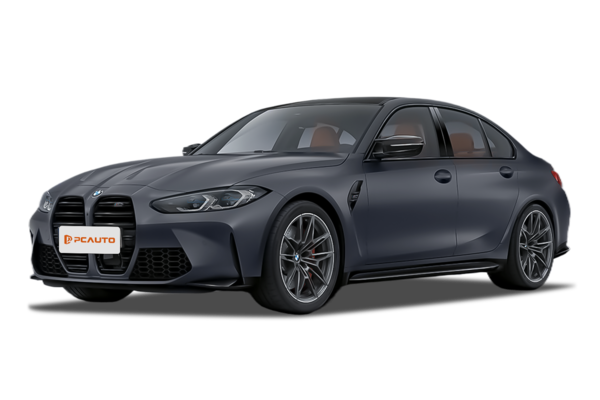Q
What engine is the BMW M3 GTR equipped with?
Under the hood of the BMW M3 GTR lies the legendary P60B40, a 4.0-liter naturally aspirated V8 engine. This high-performance powerplant, featuring a 90-degree cylinder bank angle, cranks out an impressive 350 horsepower and 365 Nm of peak torque. Mated to a 6-speed manual gearbox and tuned specifically for the track, it revs all the way up to a thrilling 8,000-rpm redline. What really sets it apart is its dual-overhead camshaft setup with four valves per cylinder, complemented by BMW's then-advanced Double-VANOS variable valve timing system. This potent combination propelled the M3 GTR to victory in the 2001 American Le Mans Series.
For Malaysian petrolheads, this engine is a rare gem with serious collector's appeal. Why? Because it was a special homologation build by BMW M Division, with only 10 road-going examples produced worldwide. The race-spec versions took things even further with lightweight materials and more aggressive tuning. It's also worth noting that this V8 left a lasting legacy, influencing BMW's subsequent high-performance engine development. You can see its technical DNA in modern M Power engines like the S65B40, which is a familiar sight in the Malaysian market today.
Special Disclaimer: This content is published by users and does not represent the views or position of PCauto.
Related Q&A
Q
Is the 2024 BMW M3 AWD?
The 2024 BMW M3 offers the xDrive all - wheel - drive version in some markets. However, the specific configuration in Malaysia should be subject to the official information released by local dealers. As a high - performance sedan, the BMW M3 is equipped with a 3.0 - liter inline six - cylinder twin - turbocharged engine, paired with an 8 - speed M Steptronic transmission. The xDrive system can actively distribute torque between the front and rear axles, enhancing handling stability on slippery roads. It's worth noting that Malaysia has a tropical rainforest climate with frequent heavy rains. The all - wheel - drive system can provide better traction when driving in the rain, but it will also slightly increase fuel consumption. The M3 also offers a rear - wheel - drive version, which is more suitable for owners who pursue pure driving pleasure. It is recommended that potential buyers choose the drive type according to their own driving habits and needs and experience the differences through test drives in person. BMW Malaysia usually holds test - drive events after the release of new cars, which is the best way to understand the vehicle's performance.
Q
How long do M3 2024 engines last?
The S58 inline-six turbocharged engine equipped in the 2024 BMW M3 is well-known for its high performance and durability. Under normal maintenance and reasonable driving conditions, this type of engine can usually cover a mileage of 200,000 to 300,000 kilometers or even more. The specific lifespan depends on the maintenance frequency, driving habits, and the impact of Malaysia's hot and humid climate on the cooling system and lubrication.
It is recommended that car owners follow BMW's official maintenance schedule, use the engine oil specified by the manufacturer (pay particular attention to the high - temperature viscosity index), and regularly check the turbocharging system and heat - dissipation components. The tropical environment may accelerate the aging of rubber pipelines and coolant.
It's worth noting that although high - performance engines are primarily designed for power output, BMW's engineering team has enhanced their durability through technologies such as forged crankshafts and closed - deck cylinder blocks. If the car is used for daily commuting rather than frequent intense track driving, its engine lifespan can be close to that of an ordinary family car.
Malaysian users also need to pay special attention to the impact of water wading during the rainy season on the intake system and the problem of oil dilution caused by long - term short - distance driving. These factors may indirectly shorten the engine lifespan.
Overall, as long as scientific maintenance is carried out, the engine of the 2024 M3 can definitely provide long - term and stable performance.
Q
What is the top speed of the BMW M3 2024?
The top speed of the 2024 BMW M3 varies depending on the configuration. The standard rear - wheel - drive version has an electronic speed limit of 250 km/h. If you opt for the M Driver's Package, it can be unlocked to 290 km/h. The Competition xDrive all - wheel - drive version can also reach 280 km/h after installing the performance package. This high - performance sedan is equipped with a 3.0 - liter inline - six twin - turbocharged engine, with a maximum output of 503 horsepower (Competition version), and is paired with an 8 - speed M Steptronic transmission. It can accelerate from 0 to 100 km/h in just 3.5 seconds (xDrive version).
For car enthusiasts in Malaysia, it should be noted that such extreme speed performance is more suitable for closed - circuit tracks. In the local tropical climate, when driving aggressively, it is recommended to closely monitor the tire condition and the efficiency of the cooling system. At the same time, high - powered rear - wheel - drive cars require extra caution on wet roads during the rainy season.
The BMW M3 has always been known for its precise handling. The 2024 model has also upgraded the M - specific differential and adaptive suspension. Even on the winding mountain roads in Malaysia like Genting Highlands, it can show excellent dynamic performance. However, for daily driving, it is recommended to use the M mode buttons on the steering wheel reasonably to adjust the intensity of power response.
Q
What is the residual value of the BMW M3 in 2024?
The residual value of the 2024 BMW M3 in Malaysia depends on factors such as the vehicle's age, mileage, condition, and market demand. Generally, the residual value rate of a 3 - year - old M3 is about 50% - 60% of the original price, but the specific figure needs to be evaluated based on the actual vehicle. As a high - performance sedan, the BMW M3 has a relatively stable residual value performance. This is thanks to its powerful S58 inline - six engine, excellent handling performance, and brand premium. Especially in the Malaysian market, BMW enjoys high recognition, which further supports the second - hand prices.
Factors affecting the residual value also include maintenance records, accident history, and optional configurations. For example, a carbon fiber roof or a sports package may increase the residual value. For potential buyers, it is recommended to obtain an accurate valuation through authoritative used - car platforms or BMW's officially certified used - car channels. At the same time, regular maintenance should be carried out to maintain the vehicle's condition.
If you are considering long - term ownership, the M3 has better value retention than ordinary models. However, the maintenance cost of high - performance cars is relatively high and should be included in the budget plan.
Q
What kind of engine is in the BMW M3 2024?
The 2024 BMW M3 is powered by a 3.0-liter inline-six twin-turbocharged engine with the code name S58. This high-performance engine can deliver 473 horsepower in the standard version, while in the Competition version, the power is boosted to 503 horsepower. It's paired with an 8-speed M Steptronic transmission or a 6-speed manual transmission (depending on the configuration), showcasing amazing acceleration performance and driving pleasure.
For car enthusiasts in Malaysia, this engine not only inherits the high-revving characteristics of the BMW M series but also optimizes the low-speed torque output through twin-turbo technology, which is very suitable for the local winding roads and high-speed cruising needs. It's worth mentioning that the S58 engine adopts advanced technologies such as a forged crankshaft and a 3D-printed cylinder head. Its heat dissipation and durability have also passed the rigorous tests on the Nürburgring track and can adapt to the tropical climate.
When comparing with performance cars in the same class, this type of inline-six engine has always been highly regarded in the Malaysian car enthusiast circle because of its smoothness and modification potential. Moreover, BMW's Valvetronic variable valve technology further balances fuel economy, which is an added bonus for car owners who consider daily commuting.
Q
How fast is a 2024 BMW M3?
The 2024 BMW M3 boasts outstanding performance. Its Competition version is equipped with a 3.0-liter inline six-cylinder twin-turbocharged engine and a peak torque of 650 Nm. Paired with an 8-speed M Steptronic transmission, it can accelerate from 0 to 100 km/h in just 3.5 seconds. The top speed is electronically limited to 250 km/h, but if you opt for the M Driver's Package, the top speed can be increased to 290 km/h. For the driving environment in Malaysia, such performance is more than sufficient, offering a powerful driving experience whether on the highway or the racetrack.
It's worth mentioning that the M3 is also fitted with the M xDrive all-wheel-drive system, which provides better grip and handling stability. Especially in Malaysia's rainy climate, the all-wheel-drive system can effectively enhance driving safety. Moreover, the chassis tuning and suspension system of the M3 have been carefully optimized to balance the comfort of daily driving and the aggressive requirements of track driving.
For Malaysian car enthusiasts who are after high-performance sedans, the 2024 BMW M3 is undoubtedly a choice worth considering. It not only has excellent acceleration capabilities but also showcases the profound expertise of the BMW M series in terms of handling and technological features.
Q
How reliable is the 2024 BMW M3?
The 2024 BMW M3 performs quite well in terms of reliability. It inherits the consistent high-performance and engineering quality of the BMW M series. The 3.0-liter inline-six twin-turbocharged engine it is equipped with has been optimized over the years. Its power output is stable, and its durability has been verified. The 8-speed M Steptronic transmission it comes with is also well - known for its smoothness and reliability.
Under the climatic conditions in Malaysia, the cooling system and electronic devices of the M3 have been specifically tuned to adapt to the high-temperature and high-humidity environment, reducing the risk of breakdowns. In addition, the official warranty and maintenance plan provided by BMW Malaysia (including a 5-year unlimited-mileage warranty) further boosts the confidence of car owners.
It's worth mentioning that the chassis and suspension system of the M3 use a large amount of lightweight materials and feature a reinforced design, balancing the comfort of daily driving and track performance. However, it is recommended to regularly check the tires and braking system to ensure safety during high-performance driving.
When it comes to the second - hand resale value, the M3 performs stably in the Malaysian market, but a specific assessment needs to be based on the vehicle's condition and mileage. For potential buyers, it is recommended to obtain detailed technical parameters and take a test drive through an authorized BMW dealer to fully understand the vehicle's characteristics.
Q
How fast does a 2024 BMW M3 go from 0 to 60?
The 2024 BMW M3 can accelerate from 0 to 60 mph (about 96 km/h) in approximately 3.4 seconds. This performance is thanks to its powerful 3.0-liter inline-six twin-turbocharged engine. It's paired with an 8-speed M Steptronic automatic transmission or a 6-speed manual transmission (in the rear-wheel-drive version), offering drivers an ultimate acceleration experience.
For car enthusiasts in Malaysia, this high-performance sedan isn't just suitable for daily driving. It can also showcase its excellent dynamic performance on the racetrack. In particular, its M xDrive all-wheel-drive system (optional) provides better traction on slippery roads, making it a great fit for the local variable climate.
It's worth mentioning that the M3 is also equipped with advanced chassis technology and lightweight design, further enhancing the handling precision. Its competitors, such as the Mercedes-AMG C63 and Audi RS5, also have strong performance. However, the M3 has more advantages in driving pleasure and personalized configuration. Especially in the Malaysian market, BMW's after-sales service network and parts supply are relatively well-established, providing more convenience for car owners.
Q
Where is the 2024 BMW M3 built?
The 2024 BMW M3 is primarily produced at the main factory of the BMW Group in Munich, Germany. This factory is renowned for its high-standard manufacturing processes and advanced technologies, ensuring that the vehicle's performance and quality meet the brand's globally unified standards. For Malaysian car enthusiasts, this high-performance model is expected to be introduced through official import channels. Local consumers can enjoy the same configurations and after-sales services as those in the global market.
As an iconic model of the brand, the BMW M3 is equipped with a 3.0-liter inline six-cylinder twin-turbocharged engine and it comes with rear-wheel drive or the M xDrive all-wheel drive system, catering to both track performance and daily driving needs.
It's worth mentioning that the hot and rainy climate in Malaysia places certain requirements on the heat dissipation of high-performance cars and tire selection. It is recommended that car owners conduct regular maintenance checks, especially on the cooling system and braking components, to ensure that the vehicle is always in optimal condition. If you're interested in purchasing, you can visit authorized dealers in Malaysia to inquire about specific configurations and prices. Some models may also offer personalized optional equipment services.
Q
What is the BMW 2024 rumor?
Regarding the rumors about BMW's new cars in 2024, the most anticipated ones at present are the launch of the all-new generation 5 Series (G60) and the electric i5. They are expected to be equipped with a more advanced autonomous driving assistance system and the upgraded iDrive 8.5 infotainment system. Meanwhile, a battery pack with higher energy density might be introduced to improve the range performance. The Malaysian market may introduce these two models in the second half of 2024.
In addition, BMW might also launch a mid-cycle facelift version of the X3. The exterior will feature a more aggressive design language and it may be equipped with a 48V mild-hybrid system to enhance fuel economy. For Malaysian consumers, these new cars may continue BMW's consistent strategy in the local market, which means offering a wide range of configuration options and local tuning to adapt to the tropical climate and road conditions.
It's worth mentioning that with the continuous promotion of new energy vehicle policies by the Malaysian government, BMW may strengthen the local layout of electric models. For example, it could increase cooperation on charging facilities or introduce more competitive after-sales service plans. However, the specific details still need to wait for further official announcements.
Popular Cars
Model Year
Car Compare
Car Photo
Latest Q&A
Q
What is the capacity of a 2 litre engine?
A 2-liter engine refers to a total displacement of 2000 cubic centimeters (cc) across all cylinders—that's 2.0 liters. This number represents the combined volume swept by the pistons moving from top to bottom dead center in each cylinder. Displacement is one of the key indicators of an engine's power output—generally, a larger displacement means more horsepower and torque, though often at the cost of higher fuel consumption.
In everyday driving, 2.0-liter engines strike a solid balance between performance and efficiency, which is why they’re commonly found in everything from compact sedans and SUVs to sportier models. That said, real-world performance isn’t just about displacement. Tech like turbocharging, direct fuel injection, or hybrid systems can make engines of the same size behave very differently.
These days, advancements in forced induction mean smaller turbocharged engines can deliver power comparable to—or even surpassing—older, bigger naturally aspirated engines while sipping less fuel. It’s no surprise that more automakers are heading in this direction.
Q
Is 2000cc the same as 2 litres?
Yes, 2000cc and 2 liters refer to exactly the same engine displacement. "cc" stands for cubic centimeter, and since 1 liter equals 1000 cubic centimeters, 2000cc is simply 2 liters – just different ways of saying the same thing.
In the automotive world, engine size is typically labeled in either liters (L) or cubic centimeters (cc). You'll see things like 1.5L or 1500cc, 1.8L or 1800cc – all describing the total cylinder volume. Generally, a larger displacement means more power, though often at the cost of higher fuel consumption.
That said, while displacement is a key spec, it doesn’t tell the whole story. Factors like turbocharging, cylinder count, and fuel injection systems also play a huge role in performance. So you can’t judge an engine purely by its size.
Also worth noting: different markets have their own preferences – some regions lean toward liters, others use cc more often. But at the end of the day, they’re measuring the exact same thing.
Q
Is a 1.5 litre engine 1500cc?
Yes, a 1.5-liter engine is indeed 1500cc. Both "liter" and "cc" (cubic centimeters) are units used to measure engine displacement. Since 1 liter equals 1000cc, 1.5 liters naturally translates to 1500cc.
Engine displacement refers to the total volume of air and fuel mixture an engine's cylinders can draw in during one complete cycle. It’s a key indicator of an engine’s size and power potential—generally, the larger the displacement, the more power it can produce, though often at the cost of higher fuel consumption.
That said, modern engine tech has come a long way. Many small-displacement turbocharged engines now deliver power outputs close to—or even surpassing—larger naturally aspirated engines, all while maintaining better fuel efficiency. That’s why we’re seeing so many cars today adopting 1.5L turbocharged engines as the sweet spot.
Of course, displacement isn’t the only factor to consider. Fuel type, cylinder arrangement, compression ratio, and other engineering choices all play a role in how an engine actually performs in the real world.
Q
Why is engine capacity measured in litres?
Engine displacement is measured in liters because it's intuitive and universally recognized. As a unit of volume, liters directly represent the total working capacity of all cylinders, making it easier for consumers to compare the power potential of different models—for instance, a 1.5L engine typically delivers more power but higher fuel consumption than a 1.0L.
This standardized approach traces back to early European automotive engineering, where engineers used total piston displacement (swept volume) to gauge performance potential. The metric system, with liters, simplified calculations and cross-comparisons.
That said, modern turbocharging has complicated the link between displacement and power. A 1.4T engine, for example, might outperform a traditional 2.0L naturally aspirated unit. So when car shopping, it’s wise to also check peak horsepower and torque figures.
On a practical note, displacement still affects road tax and insurance costs in many used-car markets, though real-world fuel efficiency hinges more on driving habits and engine tech.
Q
What is the formula for engine capacity PDF?
The formula for calculating engine capacity is: displacement (cc)=π/4 x cylinder diameter ² x piston stroke x number of cylinders, where π/4 can be simplified to 0.785, cylinder diameter and piston stroke are usually measured in millimeters (mm), and the final result is expressed in cubic centimeters (cc) or liters (L). For example, a 4-cylinder engine with a single cylinder diameter of 80mm and a piston stroke of 90mm has a displacement of 0.785 × 80 ² × 90 × 4 ≈ 1809cc or 1.8L. Displacement directly affects the engine's power output and fuel efficiency. Generally, the larger the displacement, the higher the horsepower, but fuel consumption also increases relatively. However, modern turbocharging technology can allow small displacement engines to output power close to that of large displacement engines while also considering fuel economy. When choosing engine displacement, daily usage scenarios should be considered. Small displacement engines below 1.5L are suitable for urban commuting, while engines above 1.8L can be considered for frequent long-distance driving or heavy loads. In addition, the displacement is also linked to road taxes, and common models in the local market are mostly concentrated between 1.3L and 2.5L to balance performance and vehicle costs.
View MoreRelated News

The new BMW M3 will retain the S58 engine, but it's uncertain whether it will be a hybrid model?
LienOct 11, 2024

Audi RS6 sedan version may return to compete fully with the BMW M5
WilliamNov 21, 2025

Neue Klasse platform's first mass-produced vehicle, the all-new BMW iX3 makes its debut, looks just like a concept car
LienSep 8, 2025

BMW X5 will become BMW's first model equipped with a hydrogen fuel cell, with a range of 504 kilometers
JamesSep 8, 2025

BMW's all-new iX3 to be unveiled on September 5, built on the Neue Klasse platform
Kevin WongSep 1, 2025
View More


















Pros
Cons